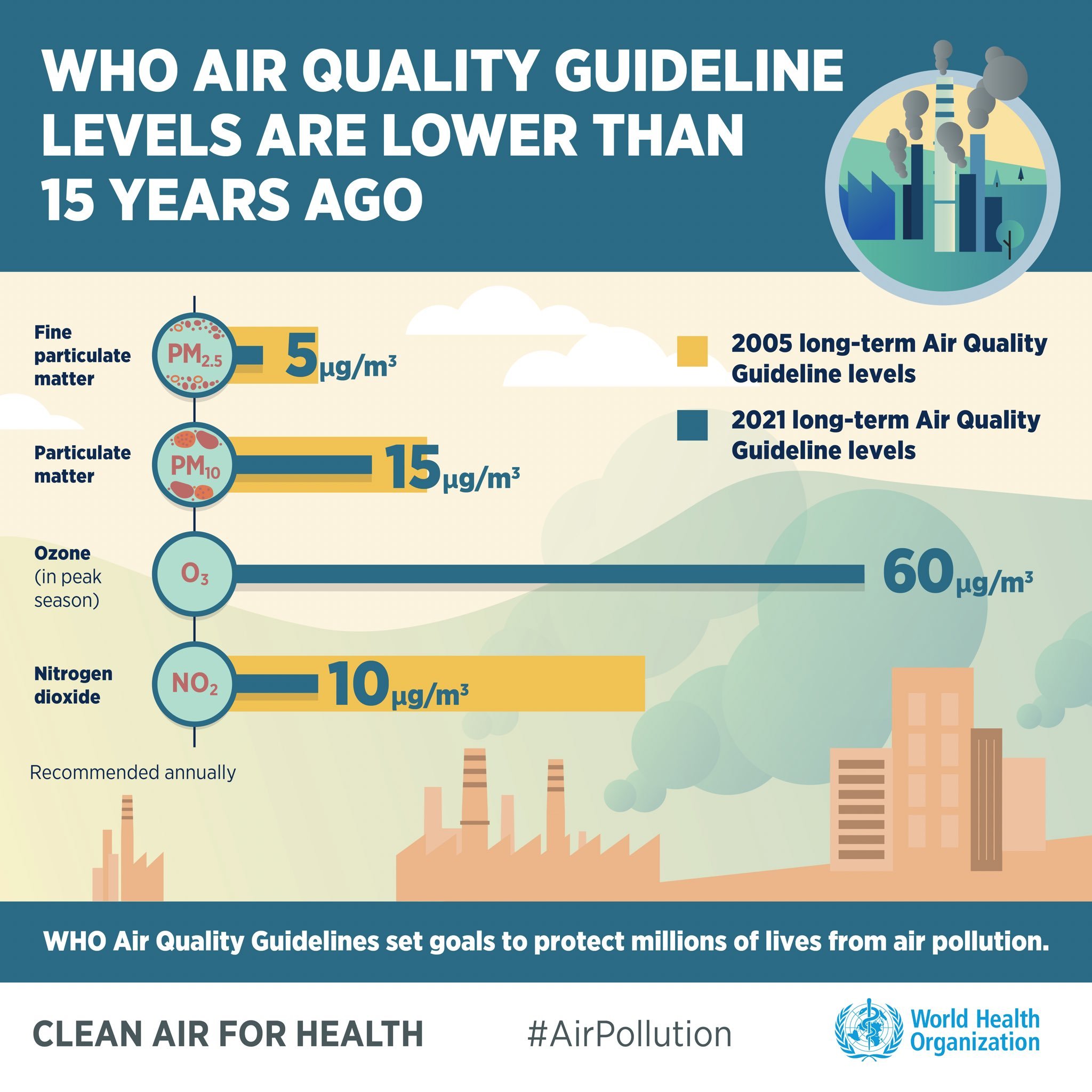
Air quality guidelines and health effects
This page describes how air quality is assessed against both short and long-term objectives in the UK
Short-term:
The Daily Air Quality Index
The reference stations and Breathe London Nodes on the homepage map are coloured according to the government’s ‘Daily Air Quality Index’ (DAQI).
This index sets short-term thresholds for each of the four main pollutants measured in the UK and grades current air quality into four ‘bands’; Low, Moderate, High and Very High. Each of these bands has separate ‘index’ levels to provide gradation between the bands. The index runs on a scale from 1-10.
Where a monitoring station or Node measures more than one pollutant, the highest current index of any pollutant is shown.
The averaging periods and concentration breakpoints for each pollutant in the index is shown in the table below.
| PM10 particulates | PM2.5 particulates | Nitrogen dioxide | Ozone | Sulphur dioxide | ||
|---|---|---|---|---|---|---|
| Band | Index | 24 hour mean (μg/m³) | 24 hour mean (μg/m³) | 1 hour mean (μg/m³) | 8 hour mean (μg/m³) | 15 minute mean (μg/m³) |
| Low | 1 | 0-16 | 0-11 | 0-66 | 0-26 | 0-88 |
| 2 | 17-33 | 12-23 | 67-133 | 27-53 | 89-176 | |
| 3 | 34-50 | 24-35 | 134-200 | 54-80 | 177-265 | |
| Moderate | 4 | 51-58 | 36-41 | 201-267 | 81-107 | 266-354 |
| 5 | 59-66 | 42-46 | 268-334 | 108-134 | 355-442 | |
| 6 | 67-75 | 47-53 | 335-400 | 135-160 | 443-531 | |
| High | 7 | 76-83 | 54-58 | 401-467 | 161-187 | 532-708 |
| 8 | 84-91 | 59-64 | 468-534 | 188-213 | 709-886 | |
| 9 | 92-100 | 65-70 | 535-600 | 214-240 | 887-1063 | |
| Very High | 10 | 101 > | 71 > | 601 > | 241 > | 1064 > |
The DAQI also provides health advice associated with each of the banding levels. These are shown below.
| Banding | Index | General population | At-risk individuals* |
|---|---|---|---|
| Low | 1-3 | Enjoy your usual outdoor activities | Enjoy your usual outdoor activities |
| Moderate | 4-6 | Enjoy your usual outdoor activities | Adults and children with lung problems, and adults with heart problems who experience symptoms should consider reducing strenuous physical activity, particularly outdoors. |
| High | 7-9 | Anyone experiencing discomfort such as sore eyes, cough or sore throat should consider reducing activity, particularly outdoors. | Adults and children with lung problems, and adults with heart problems should reduce strenuous physical exertion, particularly outdoors, and particularly if they experience symptoms. People with asthma may find they need to use their reliever inhaler more often. Older people should also reduce physical exertion. |
| Very High | 10 | Reduce physical exertion, particularly outdoors, especially if you experience symptoms such as cough or sore throat. | Adults and children with lung problems and older people, should avoid strenuous physical activity. People with asthma may find they need to use their reliever more often. |
| * Adults and children with heart or lung problems are at greater risk of symptoms. Follow your doctor's advice about exercising and managing your condition. |
Strictly, the DAQI should only be applied to reference instruments. After deliberation, we have decided to apply the index to the Breathe London Nodes to provide essential health context but to also highlight the current network accuracy of the Breathe London Nodes vs the reference network.
Long-term:
National Air Quality Objectives
The National Air Quality Strategy sets out the UK’s air quality objectives which contain the legally binding limit values that should be attained by the objective date.
These are shown in the National air quality objectives and European Directive limit and target values for the protection of human health table below.
| Pollutant | Applies | Objective | Measured as | Date to be achieved by (and maintained thereafter) | European obligations | Date to be achieved by (and maintained thereafter) |
|---|---|---|---|---|---|---|
| PM10 particulates | UK | 50 μg/m³ not to be exceeded more than 35 times a year | 24 hour mean | 31 December 2004 | 50 μg/m³ not to be exceeded more than 35 times a year | 01 January 2005 |
| UK | 40 μg/m³ | annual mean | 31 December 2004 | 40 μg/m³ | 01 January 2005 | |
| Scotland | 50 μg/m³ not to be exceeded more than 7 times a year | 24 hour mean | 31 December 2010 | 50 μg/m³ not to be exceeded more than 35 times a year | 01 January 2005 | |
| Scotland | 18 μg/m³ | annual mean | 31 December 2010 | 40 μg/m³ | 01 January 2005 | |
| PM2.5 particulates | UK | 20 μg/m³ | annual mean | 01 January 2020 | Stage 2 Limit - 20 μg/m³ | 01 January 2020 |
| Scotland | 10 μg/m³ | annual mean | 31 December 2020 | Limit value - 25 μg/m³ | 01 January 2015 | |
| UK urban areas | Target of 15% exposure reduction at urban background | annual mean | Between 2010 and 2020 | Target of 20% reduction at urban background | Between 2010 and 2020 | |
| Nitrogen dioxide | UK | 200 μg/m³ not to be exceeded more than 18 times a year | 1 hour mean | 31 December 2005 | 200 μg/m³ not to be exceeded more than 18 times a year | 01 January 2010 |
| UK | 40 μg/m³ | annual mean | 31 December 2005 | 40 μg/m³ | 01 January 2010 | |
| Ozone | UK | 100 μg/m³ not to be exceeded more than 10 times a year | 8 hour mean | 31 December 2005 | Target of 120 μg/m³ not to be exceeded more than 25 times a year averaged over 3 years | 31 December 2010 |
| Sulphur Dioxide | UK | 266 μg/m³ not to be exceeded more than 35 times a year | 15 minute mean | 31 December 2005 | - | - |
| UK | 350 μg/m³ not to be exceeded more than 24 times a year | 1 hour mean | 31 December 2004 | 350 μg/m³ not to be exceeded more than 24 times a year | 01 January 2005 | |
| UK | 125 μg/m³ not to be exceeded more than 3 times a year | 24 hour mean | 31 December 2004 | 125 μg/m³ not to be exceeded more than 3 times a year | 01 January 2005 |
Unlike the DAQI which is graded, assessment against the objectives is pass or fail. The objectives are legally binding.
Breathe London Nodes will be assessed against these objectives for each full year of data, with the indicative sensor accuracy caveat.
World Health Organisation guidelines
Around the world, nations set their own air quality targets and objectives. However, the World Health Organisation (WHO) also takes a role in setting global air quality guidelines to provide policymakers and governments with targets based on the latest scientific understanding and health research.
In September 2021 WHO updated their guidelines for the first time since 2005. Guidelines for PM10, PM2.5, and nitrogen dioxide were substantially reduced from their previous levels.
On annual graphs and statistics, reference to these WHO guidelines is also provided for reference.
WHO short-term guidelines
This graphic, produced by the WHO, shows the new 2021 short-term guidelines against the previous 2005 guidelines.
Read more about these guidelines here.
For context. the table below shows the current UK short-term, limits against the WHO guidelines. Note there is no current short-term guideline for nitrogen dioxide.
| Pollutant | UK limit value (μg/m³) | WHO guideline (μg/m³) | Averaging period |
|---|---|---|---|
| PM10 particulates | 51 | 45 | 24 hour |
| PM2.5 particulates | 36 | 15 | 24 hour |
| Nitrogen Dioxide | - | 25 | 24 hour |
| Ozone | 100 | 100 | 8 hour mean |
WHO long-term guidelines
This graphic, produced by the WHO, shows the 2021 guidelines against the previous 2005 guidelines.
Read more about these guidelines here.
For context. the table below shows the current UK annual limits against the WHO guidelines.
| Pollutant | UK limit value (μg/m³) | WHO guideline (μg/m³) | Averaging period |
|---|---|---|---|
| PM10 particulates | 40 | 15 | Annual |
| PM2.5 particulates | 20 | 5 | Annual |
| Nitrogen Dioxide | 40 | 10 | Annual |



